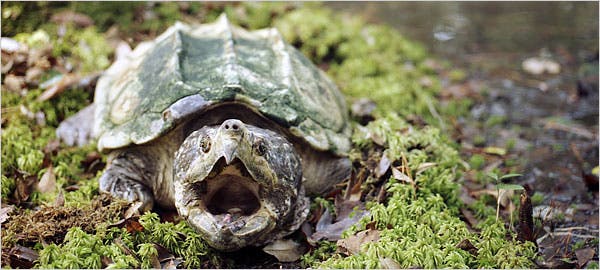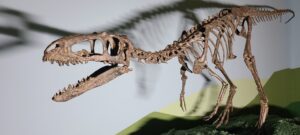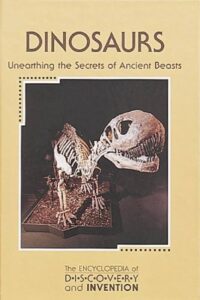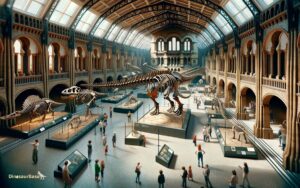What Survived Dinosaur Extinction: Ageless Survivors Revealed
Crocodilians, certain mammals, and avian dinosaurs (birds) are among the survivors of the dinosaur extinction. These species adapted to the post-extinction environment.
The catastrophic event that ended the age of the dinosaurs 65 million years ago paved the way for the survivors to thrive and evolve. Crocodilians, resembling their prehistoric ancestors, outlasted this mass extinction due to their aquatic lifestyle and ability to go dormant.
Mammals, which were mostly small and nocturnal at the time, benefited from the disappearance of their larger reptilian competitors. Present-day birds, descendants of avian dinosaurs, also made it through the catastrophe, thanks to their ability to fly, which gave them access to a range of habitats and food sources. Their adaptability allowed them to fill ecological niches left vacant by the extinction. This survival and eventual flourish of such species showcase nature’s resilience and the evolutionary shift towards new life forms post the Cretaceous-Paleogene extinction event.

Credit: www.dailystar.co.uk

Life After The Dinosaurs
Life After the Dinosaurs delves into the remarkable epoch when giant reptiles no longer ruled the Earth. After the massive extinction event 66 million years ago, known as the Cretaceous-Paleogene (K-Pg) boundary, our planet witnessed a dramatic shift. Smaller and more adaptable species took center stage in an evolutionary comeback story. Let’s explore the resilience of nature and the incredible diversity that emerged from the shadows of the dinosaurs.
Initial Survivors Of The Cretaceous-paleogene Boundary
The K-Pg boundary marks a time of significant change. A colossal asteroid impact is believed to have triggered the mass extinction. Despite the catastrophe, some life forms remarkably clung to survival. Their existence set the stage for the future of life on Earth.
- Mammals: Small, nocturnal creatures endured through their ability to find shelter.
- Amphibians: Their aquatic habitats offered some protection from the devastation.
- Birds: Descendants of theropod dinosaurs, certain species managed to survive.
- Insects: With fast reproduction rates, insects adapted and thrived post-extinction.
- Plants: Hardier species like ferns re-colonized the ravaged landscapes quickly.
Adaptive Traits That Favored Survival
Some traits turned out to be life-saving for the animals that made it through the asteroid’s aftermath. These traits became keys to flourishing in a transformed world.
| Adaptive Trait | Survival Advantage |
|---|---|
| Size | Smaller sizes needed less food and made finding shelter easier. |
| Diet Flexibility | Being able to eat different foods helped when usual sources disappeared. |
| Reproduction Rate | Fast breeders recovered their populations quicker than others. |
| Metabolic Efficiency | Less energy use meant survival with fewer resources. |
| Burrowing Ability | The capacity to dig and hide was crucial during the post-impact climate chaos. |

Credit: www.nytimes.com
The Resilient Bacteria And Microbes
When dinosaurs vanished, tiny life forms thrived. Bacteria and microbes outlasted the mass extinction. Let’s dive into their fascinating survival story.
Microbial Life During Mass Extinctions
Mass extinctions wipe out most life. Not for bacteria and microbes. These tiny organisms show exceptional survival skills. During the dinosaurs’ demise, they survived in extreme conditions. Some even flourished, adapting to new environments.
- Deep-sea vents: Microbial life thrived, unaffected by surface disruptions.
- Subterranean ecosystems: Some bacteria survived underground, safe from meteor impact effects.
- Hot springs: Heat-loving microbes found refuge and continued to multiply.
Role In Earth’s Post-extinction Recovery
Bacteria and microbes played a key role in Earth’s healing. They kick-started the recovery process. Their ability to break down dead matter recycled nutrients back into the ecosystem. This paved the way for new life forms to emerge.
| Microbe Function | Impact on Recovery |
|---|---|
| Nutrient Cycling | Restored soil fertility, supporting plant regrowth. |
| Decomposition | Recycled organic material, supporting food web reconstruction. |
| Mutualistic Relationships | Helped plants adapt to post-extinction climates. |
Arthropods: Insects And Their Kin
The cataclysm that wiped out the dinosaurs left a huge gap in Earth’s ecosystems. However, amidst this devastation, a group thrived: the arthropods. This diverse assembly includes insects, spiders, and their relatives. Their survival story is a testament to adaptability and evolutionary prowess.
Insect Survival And Evolutionary Success
Insects emerged as one of the most resilient and adaptable groups post-dinosaur extinction. Their small size, short life cycles, and varied diets helped them endure and thrive.
- Small size: Less need for food and space.
- Diverse diets: Could eat plants, debris, or other insects.
- Rapid reproduction: Quick recovery from population dips.
These factors enabled insects to exploit new niches, leading to an explosion in diversity and number. Today, they make up about 75% of all known animal species on Earth.
Crustaceans In Ancient Seas
The seas also offered shelter for survival. Crustaceans, the marine relatives of insects, found refuge underwater. Their presence in ancient seas is evident in the rich fossil record.
| Crustacean Type | Survival Strategy |
|---|---|
| Shrimp | Flexible diets and deep-sea living |
| Crabs | Hard shells for protection |
| Lobsters | Burrowing habits for safety |
Crustaceans successfully adapted to changing conditions, maintaining their presence in the oceans. Today, they continue to be an essential part of marine ecosystems.
The Age Of Amphibians And Reptiles
After the dinosaurs disappeared, our planet welcomed a new era. This era belonged to the amphibians and reptiles. These creatures showed resilience and adaptability that let them survive when the mighty dinosaurs could not.
Amphibian Ancestors Emerging Unscathed
Amphibians have a history of resilience. They faced challenges long before the dinosaurs vanished. Their ancestors found ways to survive and thrive. When the dust settled after the great extinction, amphibians already had what they needed to face the new world.
- Flexible diets: Amphibians could eat different foods, which helped them survive.
- Aquatic larvae: Their young could grow in water, safe from the changed world.
- Moist skin: This allowed for breathing through their skin, a big advantage after the event.
Reptiles That Outlived The Dinosaurs
Not all reptiles are dinosaurs, and some reptiles survived the mass extinction. These survivors are the ancestors of the reptiles we see today. Reptiles like turtles, crocodiles, and snakes found their way through the chaos.
| Reptile Group | Survival Adaptation |
|---|---|
| Turtles | Hard shells for protection |
| Crocodiles | Strong swimming ability |
| Snakes | Flexibility to hide in sheltered spaces |
Feathers And Flight: The Rise Of Birds
While the dinosaurs met their end, a new era began for their descendants: birds. These avian dynamos not only survived but thrived, thanks to unique adaptations. Let’s explore how feathers and flight charted a successful path through a changed world.
Avian Descendants Of Dinosaurs
Birds, the close relatives of dinosaurs, carry the legacy of their colossal cousins. Scientists have found links in bone structures and feathers1. This connection reveals that dinosaurs didn’t vanish completely. Parts of them lived on, taking to the skies.
Adaptations For Survival In A Post-dinosaur World
After the asteroid struck, the climate changed fast. Birds adapted with new traits to survive in a world without dinosaurs:
- Efficient Lungs: Birds evolved to have better lungs for high-altitude flight.
- Beak Variations: Diverse beaks suited different diets and environments.
- Lightweight Bones: Hollow bones made flight easier and swifter.
- Advanced Vision: Keen eyesight helped birds find food and evade threats.
These traits helped birds conquer the skies and fill ecological niches left by dinosaur extinction.
Credit: www.dailystar.co.uk
Mammals: From Shadow Dwellers To Dominant Fauna
The dinosaur extinction was a massive turning point in Earth’s history. Amid this chaos, mammals, which were once nocturnal and inconspicuous, seized an opportunity. These survivors laid the groundwork for modern fauna. In this section, we will explore the tiny mammals that beat the odds and the evolutionary journey they took to become Earth’s dominant creatures.
Early Mammals That Endured The Extinction
- Multituberculates – Small rodent-like animals with specialized teeth.
- Eutherians – Early placental mammals, ancestors of modern species.
- Marsupials – Pouched mammals that survived outside the impact zone.
Mammals like Didelphodon and Repenomamus thrived post-impact. Their ability to adapt and generalist diets helped them survive in a world reeling from the catastrophe.
Evolutionary Pathways In The Absence Of Dinosaurs
| Period | Evolutionary Development |
|---|---|
| Paleocene | Mammals diversify into new niches left vacant by dinosaurs. |
| Eocene | Appearance of early primates, horses, and whales. |
| Oligocene | Fauna dominated by large herbivores and predators. |
With dinosaurs gone, mammals evolved rapidly. They grew bigger and occupied habitats all over the world. New diets and behaviors emerged. In time, mammals became the foremost species on the planet.
Plants And Fungi: Silent Endurers
The cataclysmic event that wiped out the dinosaurs left a ravaged Earth. Plants and fungi became the unsung heroes, resiliently surviving and rebuilding the ecosystem. Their remarkable journey through the shadow of extinction paints a picture of life’s tenacity amidst chaos.
Vegetation Recovery And New Plant Species
In the wake of the dinosaurs’ exit, Earth’s landscapes were barren and bleak. Yet, life found a way. Vegetation began to reclaim the planet, ushering in a new era of botanical diversity. Plants evolved, adapted, and filled niches left vacant—a testament to nature’s enduring spirit.
- Surviving species started to regrow, forming green canopies once more.
- New plant species emerged, better suited to this modified world.
- Ferns and flowering plants became prevalent, shaping future ecosystems.
Fungal Proliferation In The Aftermath
Following the asteroid impact, the kingdom of fungi thrived in the nutrient-rich debris. The planet’s surface, covered in detritus, became a fungal paradise. This remarkable growth spurt for fungi played a key role in breaking down the organic matter, recycling nutrients back into the soil and paving the way for future growth.
| Fungal Role | Environmental Impact |
|---|---|
| Decomposers | Released essential nutrients to soil |
| Symbiotic partnerships | Supported plant species recovery |
Aquatic Life: Survival In The Seas
The story of the dinosaurs’ demise is well-known, but what about the creatures of the deep? The seas acted as a sanctuary, brimming with life amidst the chaos. Beneath the waves, a world of resilience thrived, preserving some marine species against all odds.
Marine Species That Weathered The Catastrophe
A select few marine species displayed incredible survival skills. Let’s meet these resilient ocean dwellers:
- Sharks: These ancient predators adapted well.
- Ammonites: Not all made it, but some did.
- Sea Turtles: They floated through the disaster.
These creatures shared a common ability to adapt and survive in changing conditions.
Coral Reefs: Rebuilding Marine Biodiversity
Coral reefs became the cradle for marine recovery. Their survival and expansion are noteworthy tales of resilience:
| Period | Event |
|---|---|
| Post-Extinction | Coral species diminished but survived. |
| Recovery Phase | Reefs slowly expanded, supporting new species. |
| Current Era | Reefs are diverse ecosystems, vital to ocean health. |
The reefs’ intricate structures provided shelter and food, kick-starting a new era of marine biodiversity.
Consequences And Learnings
The remarkable event that wiped out the dinosaurs forever altered life on our planet. This mass extinction, while devastating, provided invaluable insights. It paved the way for the rise of mammals, including humans. It reshaped habitats and influenced Earth’s geology and climate concretely. Understanding what survived the dinosaur extinction is not just intriguing. It offers key learnings for conserving the delicate balance of modern biodiversity.
Impact On Earth’s Geology And Climate
The asteroid impact at Chicxulub created shockwaves that transformed the globe. Geological upheavals led to new mountain ranges and ocean basins. Dust and debris from the impact caused a ‘nuclear winter’. This blocked sunlight and cooled the planet drastically. The following are key geological and climatic changes post-impact:
- Extensive earthquakes restructured the continents.
- Huge tsunamis altered coastlines worldwide.
- Volcanic activity increased leading to further climate shifts.
- Ash and soot decreased global temperatures for years.
These changes led to plant and animal adaptations essential for survival.
Insights Into Modern Biodiversity And Conservation
The dinosaur extinction provides a framework for understanding resilience in life forms. It underscores how biodiversity springs from cataclysm. Small, adaptable species thrived while larger species faltered. This pattern reveals critical conservation lessons:
- Ecosystem flexibility: Diverse habitats support recovery.
- Adaptation is key: Survival favors adaptable species.
- Genetic diversity guards against extinction.
Modern conservation efforts focus on protecting this diversity. This protects our planet against potential future calamities.
Frequently Asked Questions Of What Survived Dinosaur Extinction
Did Fish Survive The Dinosaur Extinction?
Yes, many fish species survived the dinosaur extinction event 66 million years ago. Their aquatic habitats provided a certain level of protection from the catastrophic effects that wiped out the dinosaurs.
What Animal Survived All 5 Mass Extinctions?
The horseshoe crab is an animal known to have survived all five mass extinctions.
What Plant Species Survived The Dinosaur Extinction?
Certain ferns, cycads, and conifers survived the dinosaur extinction event. These resilient plants adapted to post-extinction ecological changes.
Why Did Only Birds Survive The Dinosaur Extinction?
Birds likely survived the dinosaur extinction for their small body sizes, flight ability, and diverse diets, which enabled greater adaptability and resource access when the catastrophic event occurred.
Conclusion
As we unravel the past, the tenacity of life shines. Certain species, small mammals and resilient plants, endured the catastrophic event that sealed the dinosaurs’ fate. Their survival laid the foundation for modern biodiversity. Keep marveling at Earth’s enduring legacy and the wonders that continue to thrive against all odds.



